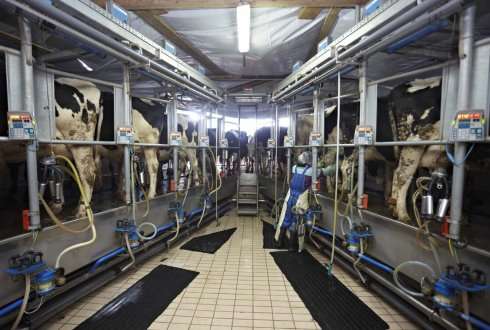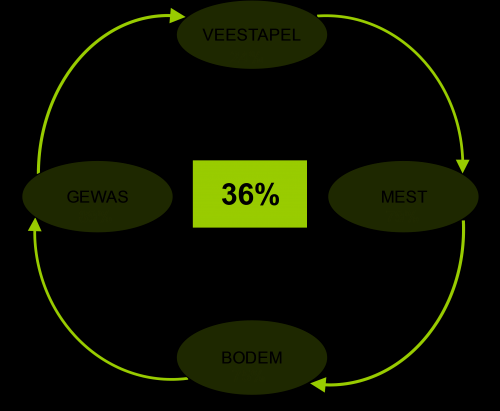Efficient use of fertilisers on dairy farms

Nitrogen and phosphate are important fertilisers. But excessive amounts often found in fields and pastures end up polluting the ground and surface water. Furthermore, dairy farmers are squandering their profits by wasting these expensive fertilisers. The Koeien & Kansen [Cattle and Opportunities] project set up by two PhD candidates from Wageningen University, part of Wageningen UR, shows how these fertilisers can be utilised more efficiently, with no adverse effects on the yield.
During the 1980s, dairy farms used 568 and 50 kg per acre of the fertilisers nitrogen (N) and phosphorous (P) respectively. The fertilisers were applied to the land in the form of cow manure or artificial fertilisers. The amount of fertiliser leaving the soil via milk and meat was 81 kg for nitrogen (14 %), and 17 kg for phosphorous (34 %). The enormous discrepancy, i.e. 487 kg of nitrogen and 33 kg of phosphorous per acre, simply disappeared into the environment. This did not only jeopardise ground and surface water, but also constituted a huge waste of minerals, an expensive commodity.
Research at De Marke
The research conducted on Wageningen UR's De Marke experimental farm together with sixteen farming concerns received funding from the Ministry of Economic Affairs, the LTO pressure group and the Dutch Dairy Commodity Board. Its aim was to rethink this situation. Environmental criteria form the parameters for milk production at De Marke, while at commercial dairy concerns, it is the other way round.
Regular adjustment of business practices
The researchers devised business practices over an extended period from 2000 to 2011, regularly adjusting them after evaluations. They considered the entire cycle whereby cattle produce manure, which is then incorporated into the soil, absorbed by crops and fed back to the animals via feed. In this respect, minerals leave the cycle via meat and milk, as well as via fertilisers. Minerals enter the cycle through extra roughage and concentrate fed to the cattle, and artificial fertilisers applied to fields and pastures. One of the unwanted side effects is minerals leaving the cycle via groundwater or the soil in the form of ammonia, phosphate, nitrate and laughing gas, for example.Cow's manure instead of artificial fertilisers

The researchers put certain measures in place along the way, in an effort to keep unwanted mineral wastage to a minimum. They used increasing amounts of their own manure instead of artificial fertilisers, kept fewer calves on the farm and allowed the cattle to graze for shorter periods. The dairy stock was fed less concentrate and the maize harvest was followed by a so-called catch crop, aimed at enabling crops to continue absorbing nitrogen and phosphate through the winter months. Fertilising with nitrogen-based artificial fertilisers was stopped altogether. The most recent measure concerned refining the manure.
De Marke managed to produce grass and maize using a much lower supply of artificial fertiliser. Mineral utilisation (which is where it all began) rose to 43% for nitrogen, a significant rise compared to statistics from the 1980s, when the national average was just 14%.
Koeien & Kansen project
The experiences and results of these changes to farming practices were shared by the sixteen dairy farmers taking part and passed to their colleagues elsewhere in the country. In this way, the Koeien & Kansen project serves as a bridge between theory and practice in the chain of research and knowledge dispersal. According to the researchers, individual farms must consider their own situation before deciding on the best way to improve efficiency.
Remarkable progress
During the project, the efficiency of nitrogen utilisation of the sixteen dairy concerns taking part in Koeien & Kansen rose to 40%. The efficiency of phosphorous utilisation for these farms is now above 80%, compared with a national average of just 34% in the 1980s; the soil P balance is almost zero. This is a remarkable achievement demonstrating significant progress. A further challenge for the future is to reduce greenhouse emissions by, for example, improving the quality of animal feed.
Sixteen farming concerns took part in this research at De Marke, which was headed by researchers Koos Verloop and Jouke Oenema, both working for Plant Research International, part of Wageningen UR. They will each be awarded a PhD this month by Prof. Martin van Ittersum, Professor of Plant Production Systems at Wageningen University.
Provided by Wageningen University

















